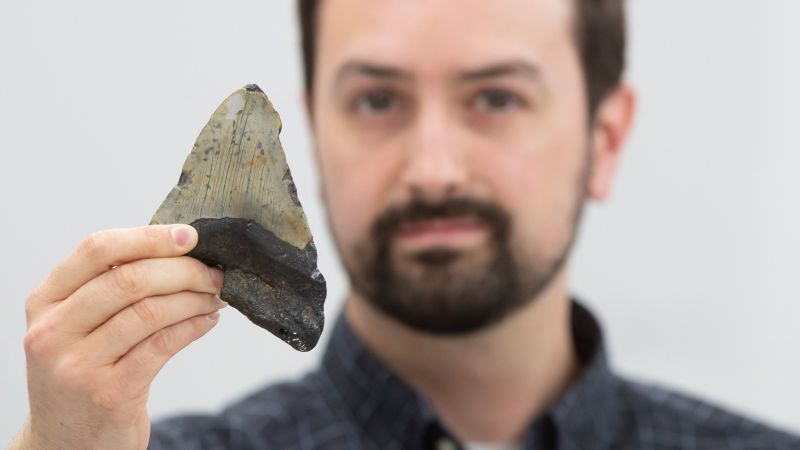The history of the colossal megalodon, one of Earth’s most famous prehistoric predators, is undergoing revision in light of new scientific insights. Traditionally thought to be a formidable hunter of large marine mammals, such as whales, recent research has presented a different picture of megalodon’s dietary habits. The study indicates that megalodon, which roamed the oceans until about 3.6 million years ago, may have been an opportunistic feeder. This conclusion is drawn from geochemical analyses of its fossilized teeth, which reveal that it likely adapted its diet based on available prey rather than focusing solely on larger creatures.
Lead study author Jeremy McCormack, a geoscientist at Goethe University in Frankfurt, Germany, explained that, while megalodon would consume large prey when it was available, it also had the flexibility to feed on smaller marine animals when larger options were scarce. This adaptability could have helped the megalodon meet its astounding caloric requirement of approximately 100,000 calories per day. The study, published in the journal Earth and Planetary Science Letters, highlights regional variations in feeding habits, suggesting that the giant shark may have sampled whatever creatures were present in local waters, including other apex predators.
The findings emphasize that megalodon did not concentrate on specific prey types. Instead, it likely fed throughout the food web, consuming a wide variety of marine species. McCormack pointed out the fierce nature of megalodon as an apex predator, asserting that while few animals would prey on a fully grown megalodon, it had the capacity to feed on nearly everything else that swam alongside it. The shark’s formidable bite and serrated teeth, which could reach over 7 inches (approximately 18 centimeters) in length, played a crucial role in its hunting prowess. The teeth, abundant in the fossil record, provided the basis for a detailed geochemical analysis that challenged the long-standing notion of megalodon as the sole ruler of the ancient seas.
Researchers have long grappled with many unanswered questions about megalodon, scientifically named Otodus megalodon, as no complete fossil of this species has ever been found. The absence of extensive fossil evidence is primarily due to the cartilage composition of sharks, which does not preserve as well as bones. Recent studies have suggested that megalodon may have exhibited warm-blooded characteristics, and there remains considerable debate regarding its size. Theories vary dramatically, with some scientists estimating it to be around 52 feet (about 16 meters) in length, while others have posited that it could have reached lengths of up to 80 feet (approximately 24 meters), surpassing the dimensions presented in fictional portrayals, such as in the 2018 film “The Meg.”
Determining megalodon’s prey through fossil evidence presents more complexities. McCormack noted that while tooth marks on the bones of large marine mammals provide clues to megalodon’s feeding behavior, such evidence is nonexistent for smaller sharks, which do not exhibit a boned structure. To gain deeper insights into the megalodon’s selection of prey, McCormack and his team compared fossilized teeth from megalodon with those of contemporary predators, using specimens housed in museums and samples from marine carcasses. The analysis focused on zinc isotopes, which assist in tracing dietary patterns by differentiating animal matter consumed.
Zinc is essential for all living organisms, playing a crucial role in various biological processes, including tooth development. The researchers discovered that different ratios of zinc isotopes in megalodon teeth reveal its place in the food web. Small fish, such as sea bream, which feed on crustaceans, were identified as lower-tier predatory animals, with megalodon at the apex, though not exclusively limited to larger prey. This flexibility in feeding patterns illustrates megalodon’s diverse dietary habits.
Moreover, the study uncovered that megalodon was not the singular apex predator in its environment. It shared this top position with other formidable species, like the Otodus chubutensis and the Araloselachus cuspidatus, thereby reinforcing the idea that megalodon was part of a competitive ecosystem rather than the isolated ruler of the oceans. This insight opens the door to understanding the factors leading to megalodon’s extinction, including possibly the rise of the great white shark, a smaller, more agile predator.
According to Kenshu Shimada, a paleobiologist and co-author of the study, the increased presence of the great white aligns with the decline of megalodon, as it adapted its diet over time. The overlap in feeding strategies suggests that the evolutionary pressures posed by the great white could have significantly contributed to megalodon’s eventual demise, as they competed for similar food resources.
The research paints a vivid picture of the marine ecosystems that thrived around 20 million years ago. Jack Cooper, a UK-based paleobiologist, emphasized the importance of this study in revealing the extent of me



